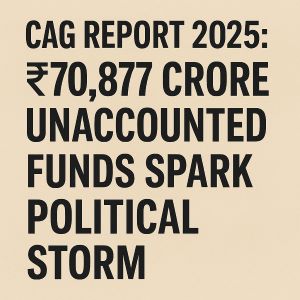Bihar CAG Report 2025
The Nitish Kumar-led Bihar government has once again come under sharp scrutiny—this time, over the questionable use of public funds. In its latest report, the Comptroller and Auditor General (CAG) of India has flagged a massive financial discrepancy amounting to ₹70,877 crore, money which was meant to be spent on government welfare schemes, infrastructure projects, schools, and rural development. Shockingly, the state government has failed to provide proper accounting or utilization certificates (UCs) for this enormous expenditure.
CAG Report Sparks Political Uproar in Bihar
The CAG report, tabled in the Bihar Legislative Assembly, has triggered intense political debate and public outrage. According to the findings, the Bihar government has not submitted utilization certificates for approximately 50,000 development schemes. This raises serious concerns about potential financial irregularities, inefficiency, and misuse of funds on a massive scale.
The lack of documentation and transparency not only violates established financial protocols but also casts a shadow on the effectiveness of governance in the state.
Understanding CAG and Its Role
The Comptroller and Auditor General (CAG) is a constitutionally mandated institution in India that audits the revenues and expenditures of the government to ensure fiscal transparency and accountability. The CAG’s reports are presented before the Parliament or respective state legislatures, serving as an essential tool for ensuring public financial integrity.
When the CAG questions the use of such a massive sum—₹70,877 crore—it implies that there has been either negligence, poor record-keeping, or deliberate mismanagement of public money. Any of these possibilities are cause for concern.
What the CAG Report Reveals
Presented recently in the Bihar Assembly, the report highlights that the government has not furnished UCs for spending linked to nearly 50,000 development projects. In other words, while funds were released and, in theory, utilized, the government has not reported where, how, and for what purposes the funds were actually spent.
Even more alarming is the fact that around ₹15,000 crore worth of these expenses date back to before the 2016–17 fiscal year, suggesting that the lack of financial reporting has been an ongoing issue for many years.
Which Departments Are Under the Scanner?
Several key departments—particularly those tasked with managing public infrastructure and welfare—have come under the spotlight for unaccounted expenses:
Panchayati Raj Department: Over ₹28,000 crore remains undocumented.
Education Department: Fails to account for ₹13,000 crore.
Urban Development, Rural Development & Agriculture Departments: All face serious questions regarding financial transparency.
These departments are responsible for the core areas of public service—schools, roads, irrigation, and community infrastructure. When funds vanish without explanation in these sectors, it directly affects the quality of life for citizens and raises doubts about the intent and competence of the administration.
Unauthorised Spending Through AC Bills
The CAG report also draws attention to unauthorized expenditures made without budgetary approval, particularly through AC (Abstract Contingent) bills.
In March 2020 alone, the Bihar government spent ₹644 crore without legislative sanction. These funds were disbursed through AC bills—an instrument meant for emergency advances or provisional spending, which must later be regularized with detailed records via DC (Detailed Contingent) bills.
However, in this case, no such records were submitted, violating basic financial discipline. The report indicates that this is not an isolated instance—similar patterns were observed in previous audits, including the CAG report for the financial year 2022–23. Such repeat offenses suggest systemic flaws and a worrying culture of fiscal irresponsibility.
Bihar’s Financial Management in Question
The revelations paint a grim picture of Bihar’s financial health. Despite formulating annual budgets, the government appears to be falling short in tracking and managing expenditures. Worse still, large portions of public money are being spent without public knowledge or approval.
This lack of oversight raises serious questions:
Where is the money going?
Is it being used for intended purposes?
Is there any political or bureaucratic misuse of these funds?
Furthermore, the state’s public debt continues to rise, yet there is little clarity on how the borrowed money is being utilized. In some cases, spending has been done for activities that may not have even been necessary, pointing to possible misallocation of funds.
Opposition Reacts, Public Anger Grows
Unsurprisingly, the CAG report has created a political storm. Opposition leaders in the Bihar Assembly were quick to seize the opportunity, demanding answers from the ruling party.
Questions were fired across the House:
“Where has ₹70,000 crore disappeared?”
“Is this a case of financial scam or administrative negligence?”
“Why has the government remained silent?”
On social media, too, citizens have expressed anger and disappointment, demanding accountability and transparency. Hashtags calling for a CBI investigation and strict audits have begun trending, reflecting public frustration with what appears to be a failure in governance.
CAG’s Recommendations: Time for Reforms
To address the crisis, the CAG has issued strong recommendations for immediate action:
All pending Utilization Certificates must be submitted without further delay.
The budget control mechanism needs urgent strengthening to ensure expenditures align with legislative approvals.
A robust financial monitoring system must be put in place to detect anomalies in real-time and prevent repeat violations.
However, while recommendations are welcome, implementation remains the key challenge. Unless the state government acts swiftly and decisively, the trust deficit between the public and the administration will only widen.
The Bigger Question: Is Public Money Safe?
Ultimately, this controversy is about more than just numbers—it’s about public trust. People expect their tax money to be spent on essential services, not lost in bureaucratic black holes. The government’s failure to account for ₹70,877 crore is not just a financial lapse; it is a breach of public confidence.
The onus now lies squarely on Chief Minister Nitish Kumar and his administration to come clean, hold those responsible accountable, and restore fiscal integrity in the governance of Bihar.
Until then, the cloud of doubt will continue to loom large over Bihar’s financial practices.

